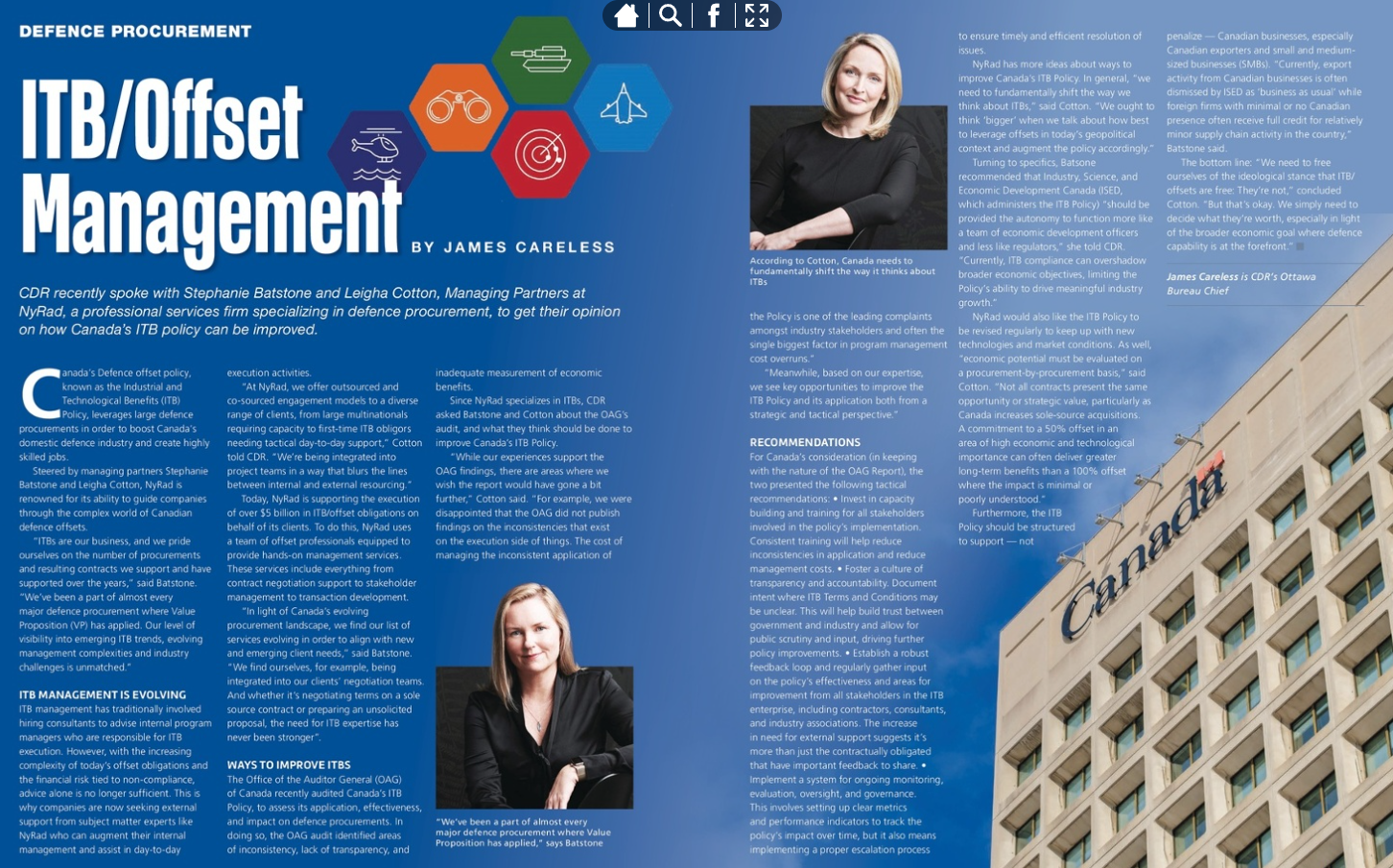UORs Necessitate an Innovative Approach to ITB/VP Application
Designating a procurement an Urgent Operational Requirement (UOR) allows the federal government to dispense with traditional procurement processes in order to procure essential equipment on an accelerated timeline. It allows Canada to respond to urgent threats or capability gaps that cannot be met using conventional procurement mechanisms. As experts in Canadian defence procurement, NyRad Inc. recognizes the critical role UORs play in maintaining operational readiness and effectiveness.
Undertaking UORs, however, introduces distinct challenges for those managing the expedited procurement process. Embracing these challenges requires adaptability and a willingness to find balance within a traditionally rigid system. This can be particularly demanding for those who are risk-averse, yet it presents an opportunity to develop new procurement strategies and strengthen procurement outcomes. This balance is especially required when applying ITB/VP requirements to UOR procurements.
For these reasons, we propose the following considerations for Canada when integrating Industrial and Technological Benefit (ITB) and Value Proposition (VP) requirements into UORs:
Revision of ITB Plan Submission Timelines
The current expectation for Bidders to submit standard, full-length ITB Plans (including regional, development, small and medium-sized business (SMB) development, and management plans) at the time of bid submission (often within a 30–60-day window) is impractical. Imposing such a requirement is also incongruent with the urgent nature of the procurement – placing undue emphasis on aspects that the bidders have little time to affect, given the tight timelines as well as the fact that UORs are seeking off-the-shelf solutions. In the interest of quality, we propose Canada consider moving the requirement for ITB plans until 6-12 months after the contract is awarded. This modification would enable the successful contractor to develop more comprehensive ITB plans with enhanced fidelity in implementation. It would also alleviate the administrative load during the bidding process, allowing bidders to dedicate their efforts to addressing the pressing matters of urgency.
Simplification of Value Proposition Criteria
While the VP is instrumental in ensuring high-quality economic activity on defence procurements, it also adds a level of complexity to the bidding process that can influence a bidder’s assessment of risk and, therefore, add cost. This is especially true when it comes to UORs. While it may not be feasible to eliminate the Value Proposition (VP), we encourage Canada to exercise heightened discretion in its application to UORs. It is important to consider which of the five VP pillars most effectively align with the procurement’s objectives, considering not only the product or service being acquired but also the urgent nature of the procurement process. When it comes to simplifying the VP on UORs, we offer the following two suggestions for Canada’s consideration:
- The Direct VP Pillar, while critical on most defence procurements, may not have the same place on UORs. After all, most, if not all UORs are seeking off-the-shelf equipment. This, by its very nature, limits a bidder’s ability to augment the Canadian content within its solution. Placing too much emphasis (i.e., VP points) on Direct Canadian Content Value (CCV) incentivizes bidders to make changes that are inconsistent with the overarching goal of a UOR. Changing suppliers, for example, on a UOR solution can add time, cost, and undue risk to a bidder’s offer. As such, considering the weighting of the Direct VP Pillar will help incentivize other (often indirect) VP activities that will not pull bidders away from the single most important requirement driving UORs, which is the speed of delivery.
- While Export plays an important role in many defence procurements, leveraging the Export VP Pillar as part of a UOR and requiring bidders to submit an Export plan in support of its commitments adds a level of complexity that is difficult to address in 1-2 months. Expecting bidders to generate export opportunities within such a short timeframe is unrealistic. With this in mind, we suggest that the Export Pillar be removed for UORs. This will help streamline the bidding process, reduce the bidders’ workload, and help focus the VP on areas where contractors have more control.
Modification of Identified Transaction Requirement
The current requirement for bidders to identify the equivalent of 30% of their bid price in eligible Transaction Sheets at bid time is unrealistic for UORs. Though this is the standard on most other procurements (where the ITB Policy is applied), UOR timelines are such that specificity is exceptionally difficult. We propose that ISED look to reduce identification requirements at bid time and push Tranche 1 identification requirements until 12 months post-contract award. This would offer bidders greater flexibility and more time to focus on documenting their technical solutions, pricing, and overall ITB/VP commitments during the shortened bid timeline.
At the end of the day, UORs demand rapid delivery of off-the-shelf equipment. The ability to meet imposed timelines supersedes most other requirements. Without flexibility and a readiness to adapt procurement practices for the sake of expediency, the very essence and effectiveness of the UOR as a critical procurement instrument is compromised.
You May Also Be Interested In...

Editorial: ITB/Offset Management -How Canada’s ITB Policy Can Be Improved
Excited to share that NyRad is featured in the latest edition of the Canadian Defence Review.


